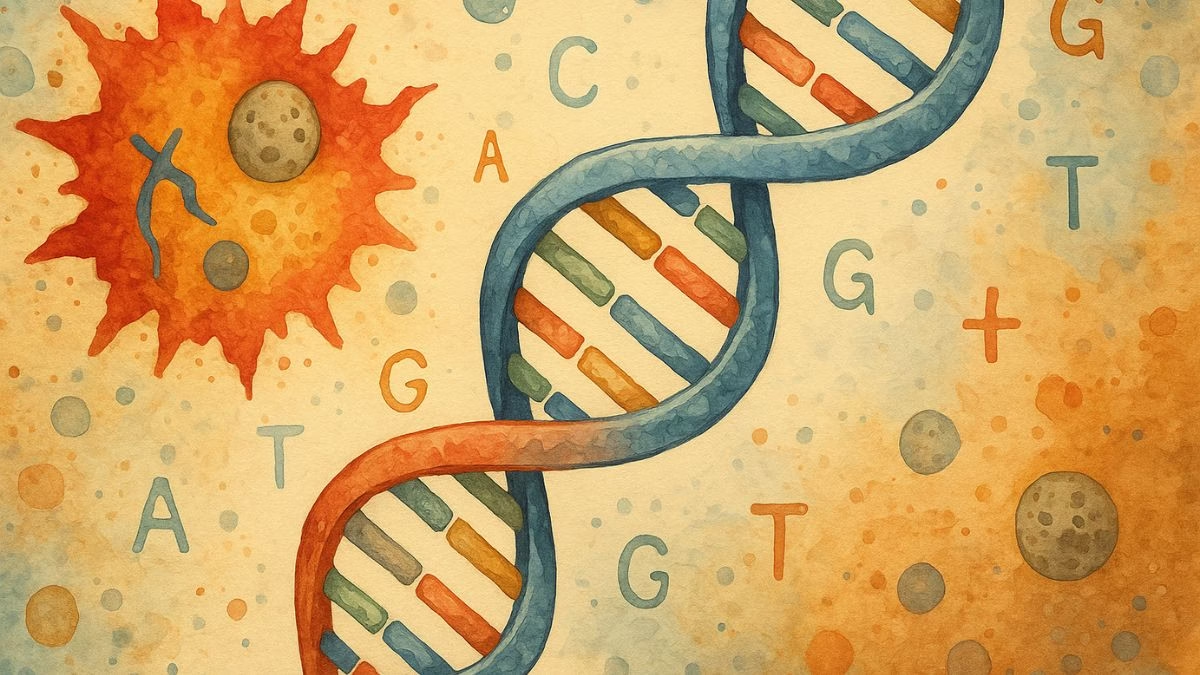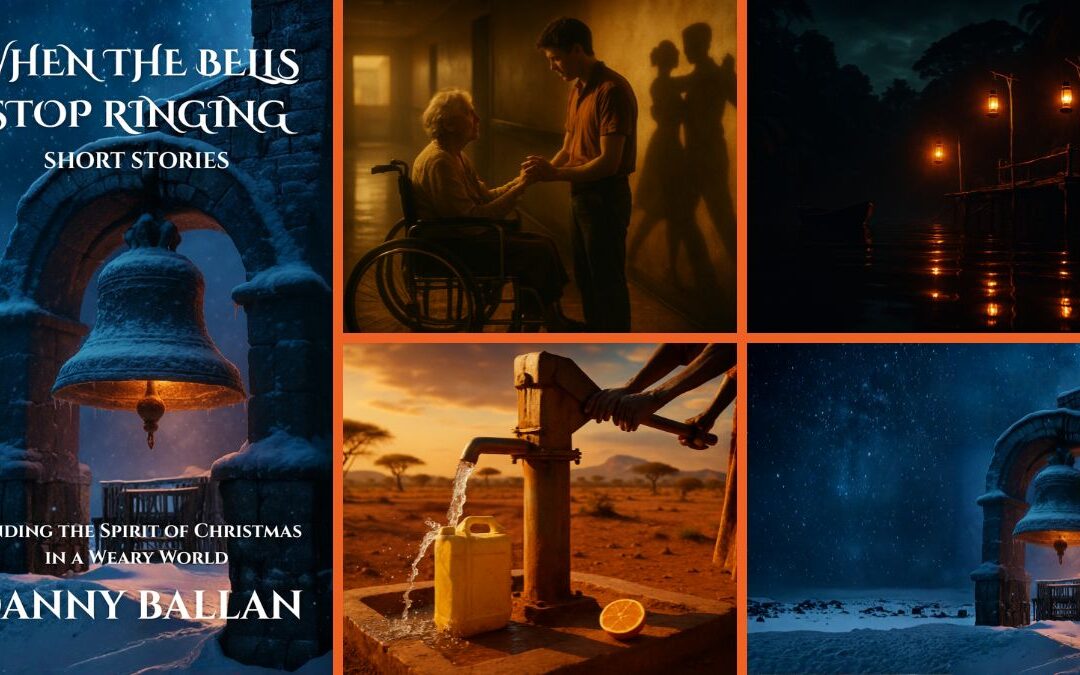- The Blueprint of Life: A Quick Refresher on DNA
- What Exactly Is a Genetic Mutation?
- The Source Code: Where Do Mutations Come From?
- The Good, the Bad, and the Silent: The Impact of Mutations
- The Engine of Evolution: How a “Mistake” Creates Majesty
- English Plus Magazine Podcast
- Focus on Language
- Let’s Learn Vocabulary in Context: The Quiz
- Let’s Discuss
- Learn with AI
- Let’s Play & Learn
The word “mutation” comes with some heavy baggage. Say it out loud, and it conjures images from the B-list of science fiction: radioactive spiders, monstrous creatures lumbering out of a toxic swamp, superheroes gaining extraordinary powers from a cosmic ray. In our popular imagination, a mutation is a dramatic, often grotesque, deviation from the norm. It’s an error, a glitch in the system, a corruption of the code.
And in a strictly technical sense, some of that is true. A genetic mutation is an error. It’s a typo in the sprawling, elegant instruction manual of life. But here is the profound and beautiful paradox: these very mistakes are the raw, unbridled source of all of life’s breathtaking diversity. Without the haphazard glitches in our genetic code, evolution would grind to a halt. There would be no adaptation, no innovation, no glorious branching tree of life. Every living thing on this planet, from the smallest bacterium to the blue whale, including you, is the magnificent result of a 4-billion-year-long chain of beautiful bugs.
To truly understand our world, we must reframe our understanding of this loaded word. We need to move past the comic book panels and into the cellular machinery to see mutations for what they really are: not a flaw in the design of life, but its most essential and creative feature.
The Blueprint of Life: A Quick Refresher on DNA
Before we can talk about a typo, we need to understand the book it’s written in. Every living organism carries a detailed instruction manual inside each of its cells. This manual is DNA (Deoxyribonucleic acid).
Think of DNA as a colossal cookbook. This cookbook contains all the recipes—called genes—needed to build and operate an entire organism. The alphabet used to write these recipes is incredibly simple, consisting of just four letters: A (adenine), T (thymine), C (cytosine), and G (guanine). These letters, called bases, are strung together in long, elegant sequences.
These letters form three-letter “words” called codons, and each codon specifies a particular ingredient, an amino acid. String the amino acids together in the right order, and you get a protein. Proteins are the workhorses of the cell; they are the bricks, mortar, engines, and messengers that do almost everything. A gene, then, is simply a recipe for a specific protein. A single change in a letter can change a word, which can change the recipe, which can ultimately change the protein and the trait it controls.
What Exactly Is a Genetic Mutation?
With that in mind, the definition of a genetic mutation is stunningly simple: it is a permanent alteration in the sequence of DNA’s letters. It’s a typo in the cookbook. But just as there are different kinds of typos, there are different kinds of mutations, each with a potentially different consequence.
The Typo: Point Mutations
The most common type of mutation is a point mutation, where a single letter in the DNA sequence is changed. Imagine a simple recipe instruction: “THE FAT CAT ATE THE RAT.”
- Substitution: This is a simple swap of one letter for another. If ‘C’ is swapped for ‘R’, the instruction might become “THE FAT RAT ATE THE RAT.” A small change, but the meaning is altered. In genetics, this can cause one amino acid to be swapped for another, which might slightly or dramatically change the resulting protein. A classic example is sickle cell anemia, which is caused by a single letter substitution in the gene for hemoglobin.
The Garbled Sentence: Frameshift Mutations
These mutations are more disruptive. They occur when a letter is either added (insertion) or removed (deletion). Because the DNA code is read in three-letter words, this single change throws off the entire reading frame from that point onward, creating a stream of gibberish.
Let’s go back to our sentence: “THE FAT CAT ATE THE RAT.”
- Deletion: Let’s remove the ‘F’ from FAT. The cell, still reading in three-letter words, now sees: “THE ATC ATA TET HER AT.” The entire recipe downstream of the error becomes nonsensical.
- Insertion: Let’s add an extra ‘A’ after FAT. The sentence becomes: “THE FAT ACA TAT ETH ERA T.” Again, pure gibberish.
Frameshift mutations almost always result in a non-functional protein because the recipe becomes completely scrambled.
The Rearranged Chapter: Chromosomal Mutations
Sometimes, the errors are much larger than a single letter or word. Entire chunks of DNA—whole chapters of the cookbook—can be deleted, duplicated, inverted, or even moved to a completely different chromosome (a volume of the cookbook). These large-scale changes are often, though not always, detrimental to the organism, as they can affect hundreds or thousands of genes at once.
The Source Code: Where Do Mutations Come From?
If mutations are typos, who or what is the clumsy typist? The sources of these genetic alterations fall into two main categories.
Built-in Bugs: Spontaneous Mutations
Most mutations are simply the result of natural, internal processes. Your body is made of trillions of cells, and these cells are constantly dividing to replenish tissues and fuel growth. Every time a cell divides, it must make a perfect copy of its entire DNA cookbook—all 3 billion letters of it.
The molecular machinery that does this copying is astonishingly accurate, but it’s not perfect. It makes a mistake roughly once every 100,000 to 1 million letters. Given the sheer scale of the genome, this means that every new cell in your body likely contains a handful of new, spontaneous mutations. These are not caused by anything sinister; they are the intrinsic, unavoidable “bugs” in the system of life.
External Sabotage: Induced Mutations
Sometimes, the genetic code is damaged by outside forces. These external agents that can cause mutations are called mutagens. They are the saboteurs that attack the cookbook.
- Radiation: High-energy radiation, like UV rays from the sun or X-rays, can physically break the DNA strands or cause the letters to fuse together incorrectly. This is why sun exposure is a major risk factor for skin cancer—the UV rays induce mutations in skin cell DNA.
- Chemicals: A vast array of chemicals can sneak into our cells and interfere with DNA. Some chemicals in cigarette smoke, for example, are powerful mutagens that can lead to mutations causing lung cancer.
- Viruses: Some viruses are particularly insidious. They hijack a cell’s machinery and insert their own genetic code into the host’s DNA, a process which can disrupt gene function and induce mutations.
The Good, the Bad, and the Silent: The Impact of Mutations
So, a typo has occurred. What happens next? The popular sci-fi view is that the outcome will be dramatic. In reality, the consequences of a mutation fall along a spectrum.
The Bad: When Errors Cause Harm
This is the category we are most familiar with. When a mutation occurs in a crucial gene, it can lead to a non-functional or harmful protein, resulting in a genetic disorder. Diseases like cystic fibrosis, Huntington’s disease, and the aforementioned sickle cell anemia are all caused by specific mutations that have deleterious effects on the body. Cancer is also a disease of mutation, arising when changes in specific genes cause a cell to grow and divide uncontrollably.
The Silent Majority: Neutral Mutations
This is by far the most common outcome. The vast majority of mutations have no discernible effect on an organism’s health or survival. A mutation might occur in a non-coding region of DNA (the “filler” pages between recipes). It might change a DNA letter but, due to redundancies in the genetic code, still result in the same amino acid. Or, it might change an amino acid to a different but chemically similar one, resulting in a protein that works just fine. These neutral mutations are the silent background hum of genetics, accumulating over time without making a fuss.
The Game-Changers: Beneficial Mutations
This is the rarest and, for evolution, most important category. Every once in a while, by sheer chance, a mutation occurs that gives an organism a slight advantage in its specific environment. This is not a superpower; it is a small, practical edge.
- Lactose Tolerance: Most adult mammals cannot digest milk. But in human populations that domesticated cattle thousands of years ago, a mutation arose that kept the lactase gene (the recipe for the milk-digesting enzyme) switched on into adulthood. In a world where milk was a rich source of calories, this was a huge beneficial mutation.
- Antibiotic Resistance: A bacterium in a population might have a random mutation that allows it to survive an antibiotic drug. While all its non-mutated cousins are wiped out, this one bacterium survives, reproduces, and passes on its resistant gene, leading to a new, drug-resistant superbug strain. This is evolution happening in real-time, right before our eyes.
The Engine of Evolution: How a “Mistake” Creates Majesty
This brings us to the grand synthesis. How do these rare, beneficial “mistakes” lead to the vast complexity of life we see around us? The answer lies in the beautiful partnership between random mutation and the non-random filter of natural selection.
Step One: The Random Lottery of Variation
It is imperative to understand that mutations are random. The environment does not cause a specific, helpful mutation to occur. The mutation that granted lactose tolerance didn’t arise because people started drinking milk. It was a haphazard copying error that just happened to be useful in that new cultural context. Mutation is constantly throwing new genetic lottery tickets into a population, creating a pool of variation. Most of these tickets are duds (neutral or harmful), but a very few are winners.
Step Two: The Filter of Natural Selection
Natural selection is the process that cashes in the winning tickets. It is the simple and inescapable reality that individuals with traits better suited to their environment are more likely to survive, reproduce, and pass those traits on to the next generation.
The environment acts as a filter. In an area with domesticated cattle, the individuals with the lactose tolerance mutation had a better chance of surviving and having healthy children. In a hospital saturated with antibiotics, the bacteria with the resistance mutation are the only ones that get to reproduce. Over many generations, this filtering process causes beneficial mutations to become more common in a population, gradually changing the population’s characteristics. This gradual change is the very essence of evolution.
Conclusion: The Beautiful Imperfection of Life
The story of genetics is a story of imperfection. The system is designed to copy itself, but the copying process is flawed. And in that flaw lies all of its potential. Mutations are not a deviation from the story of life; they are the authors of it. They provide the new words, the rephrased sentences, and the surprise plot twists. Natural selection is simply the editor, choosing which of those changes make the story better and more likely to continue.
So the next time you hear the word “mutation,” try to look past the sci-fi monsters. Think instead of the random, beautiful bug that allowed our ancestors to thrive on a new food source, or the error that gave a plant a brighter flower to attract more pollinators. These mistakes are the source of life’s genius. They are the haphazard, unpredictable, and ultimately indispensable engine that has driven the evolution of every magnificent life form on Earth.
English Plus Magazine Podcast
Focus on Language
Vocabulary and Speaking
Let’s dive into the vocabulary from our exploration of genetic mutations. When we talk about complex scientific topics, using precise and vivid language is key to making the subject both understandable and exciting. The words we choose can turn a dry explanation into a compelling story. Let’s look at some of the words we used and how you can incorporate them into your everyday speech.
A word we used right at the beginning to describe the nature of mutation was haphazard. Haphazard means lacking any obvious principle of organization; random. It describes something that is done without a plan or care. If you organize your files in a haphazard way, it means you’re just throwing them into a drawer without any system. In our article, it was crucial to explain that mutations are haphazard—they don’t happen because an organism “needs” them. They are random events. You could say, “His approach to studying for the exam was completely haphazard; he just opened the book to random pages.”
To describe the negative effects of some mutations, we used the word detrimental. Something that is detrimental tends to cause harm; it’s damaging. It’s a more formal and powerful way to say “harmful” or “bad for you.” You could say, “A lack of sleep can be detrimental to your health.” Or, “The new policy had a detrimental effect on employee morale.” It’s a great word for formal or professional contexts when you want to describe a negative impact. A close synonym we also used was deleterious, which also means causing harm or damage. It’s slightly more formal and often used in scientific or medical contexts, but carries the same meaning of harmful effect.
In contrast, we described the process of spontaneous mutation as an intrinsic part of life. Intrinsic means belonging naturally; essential. It describes a quality that is fundamental to the nature of a thing. The desire to connect with others is an intrinsic part of the human experience. The intrinsic value of a piece of art is its artistic merit, separate from its monetary price. When we say mutations are an intrinsic part of DNA replication, we mean the potential for error is built into the very system itself; you can’t have one without the other.
It was imperative to understand that mutations are random. When something is imperative, it is of vital importance; it is crucial. It’s a very strong word that signals something is absolutely necessary. It’s more powerful than saying “it’s important.” A doctor might say, “It is imperative that you finish your full course of antibiotics.” A leader might say, “For this project to succeed, teamwork is imperative.” Use it when you want to convey absolute necessity.
We talked about how natural selection is a cornerstone of the theory of evolution. A cornerstone is a vital part of something, the basis or foundation on which everything else is built. Literally, it’s the first stone set in the construction of a building’s foundation, important for determining the position of the entire structure. Metaphorically, you could say, “Trust is the cornerstone of any strong relationship.” Or, “The right to free speech is a cornerstone of democracy.” It signifies a fundamental, indispensable principle.
The partnership between mutation and natural selection is a perfect example of synergy. Synergy is the interaction of two or more things to produce a combined effect greater than the sum of their separate effects. It’s the classic idea that 1 + 1 = 3. A great business partnership has synergy, where the skills of the two partners create a more successful company than either could have built alone. A musical duo has synergy when their voices and styles blend to create a unique sound. Mutation on its own is just random change; natural selection on its own has nothing to select from. Together, they create the synergy that drives evolution.
When an organism has a trait that is a disadvantage, it can be a liability. A liability is something that puts one at a disadvantage. It’s a state of being responsible for something, especially by law, but in a broader sense, it’s just a handicap. An old, unreliable car can be a major liability when you have a long commute. In a team project, a member who doesn’t do their share of the work is a liability to the whole team. A mutation that causes a disease is a biological liability.
On the other hand, a trait that is well-suited to the environment is an asset. An asset is a useful or valuable thing or person. Strong communication skills are a huge asset in any career. For a company, its dedicated employees are its greatest asset. It’s the direct opposite of a liability. A beneficial mutation provides a new and valuable asset to an organism.
The process of natural selection can be described as inescapable. If something is inescapable, it is unable to be avoided or denied. The conclusion was inescapable. The passage of time is an inescapable reality of life. It implies a sense of inevitability. The logic of natural selection—that those who are better suited to their environment tend to leave more offspring—is an inescapable consequence of the principles of heredity and variation.
Now, for our speaking section. Today’s skill is explaining a complex process using an analogy. Science is full of complex processes that can be hard to understand. An analogy is a comparison between two things, typically for the purpose of explanation or clarification. It’s a bridge from something your listener doesn’t know to something they do know. In the article, we used the analogy of a “cookbook” for DNA. This is much easier to grasp than “a macromolecule composed of two polynucleotide chains…”
The key to a good analogy is simplicity and relevance.
- Identify the core concept: What is the most important idea you need to get across? (e.g., DNA is an instruction manual).
- Find a familiar parallel: What in everyday life works in a similar way? (A cookbook, a computer code, a blueprint).
- Map the parts: Connect the parts of your analogy to the parts of the complex topic. (Genes are recipes, codons are words, proteins are the finished dishes).
- Don’t overextend it: Acknowledge where the analogy breaks down. All analogies are imperfect.
Let’s try it. Imagine you have to explain the synergy between mutation and natural selection.
“You can think of it like a sculptor. Mutation is like a haphazard process of just adding random lumps of clay to a statue. Most of the lumps don’t help, they might even make it look worse. But every now and then, a lump is added in just the right place. That’s where natural selection comes in. Natural selection is the sculptor, who sees that one useful lump of clay and decides to chip away all the other useless bits, leaving behind a new, improved form.”
Here’s your challenge for this week. Pick a complex process or idea you understand well. It could be from your job, a hobby, or another area of science. Your challenge is to create a simple, clear analogy to explain it to someone who knows nothing about it. Prepare a one-minute explanation using your analogy. Try to use at least one of our vocabulary words, like cornerstone, synergy, or imperative. Record yourself. Does your analogy make the complex topic easier to understand? This is a cornerstone skill for being a great teacher, leader, and communicator.
Grammar and Writing
The Writing Challenge
The article explained that evolution is a beautiful partnership between two forces: random genetic mutation, which creates variation, and natural selection, which filters that variation. This two-step process—random change followed by non-random filtering—is not unique to biology. It can be seen in the evolution of technology, ideas, art, and even personal habits.
For this writing challenge, your task is to apply the concept of “mutation and selection” to a non-biological topic. Choose a subject like the evolution of smartphones, the development of a musical genre (like hip-hop or rock and roll), the changing fashions in clothing, or the development of your own career path or a specific skill you have.
Write a 500-750 word essay that explains how your chosen topic has “evolved” through a similar two-step process:
- The “Mutations”: Describe the random or haphazard new ideas, innovations, or changes that were introduced. (e.g., in smartphones, this could be new features like cameras, touch screens, or different app ideas).
- The “Natural Selection”: Describe the “environmental” pressures that filtered these changes. What made some ideas successful and caused others to fail? (e.g., consumer demand, market competition, cultural trends, practical utility).
Your goal is to use the powerful framework of evolution as a metaphor to explain change and development in another area of life.
A Grammar and Writing Lesson to Ace Your Essay
Writing an essay that uses a scientific concept as a metaphor for something else is a sophisticated task. It requires you to be clear, organized, and in control of your language. Let’s look at some grammatical and stylistic techniques that will help you build this extended analogy successfully.
Part 1: The Power of Parallel Structure
When you are comparing two things (like biological evolution and technological evolution), using parallel structure is essential for clarity. Parallel structure means using the same pattern of words to show that two or more ideas have the same level of importance. This can happen at the level of words, phrases, or entire clauses.
- Not Parallel: “The process requires random mutations and also filtering the changes through natural selection.”
- Parallel: “The process requires random mutations and the non-random filtering of those mutations.” (Parallel noun phrases)
- Parallel: “Mutations create the variation, and natural selection chooses the winners.” (Parallel clauses)
For your essay, you can use this at a larger scale to structure your argument. You could structure your essay like this:
- Paragraph 1 (Biology): “In biology, random mutations provide the raw material for change…”
- Paragraph 2 (Your Topic): “Similarly, in the evolution of music, new and haphazard styles provide the raw material for change…”
By consciously using the same sentence structures and verb tenses when discussing the two sides of your analogy, you make the comparison clear, elegant, and easy for the reader to follow.
Part 2: Using Colons and Semicolons to Connect Ideas
Proper punctuation can elevate your writing from good to great. Colons (:) and semicolons (;) are powerful tools for connecting ideas with precision.
- The Colon (:) for Explanation or Elaboration
A colon is used after a complete sentence to introduce a list, a quote, or an explanation of the sentence that came before it. It says to the reader, “and here’s what I mean.”
- To introduce a list: “The smartphone ‘mutations’ were numerous: bigger screens, better cameras, and faster processors.”
- To provide an explanation: “The result was an inescapable conclusion: the market preferred simplicity.”
- Use it in your essay to define a key part of your metaphor: “This brought a new selective pressure to the forefront: user experience.”
- The Semicolon (;) to Join Two Closely Related Sentences
A semicolon connects two independent clauses (sentences that could stand on their own) that are too closely related to be separated by a period. It suggests a tighter, more intimate connection.
- Instead of: “Random mutations are the source of variation. Natural selection is the filter.”
- Try: “Random mutations are the source of variation; natural selection is the filter.”
- Use it in your essay to draw a direct parallel: “In biology, most mutations are neutral; in technology, most new features fail to catch on.”
Mastering the colon and semicolon will make your writing more sophisticated and allow you to express complex relationships between ideas with greater nuance.
Part 3: Word Choice – Formal vs. Informal Language
Since you are writing an analytical essay based on a scientific concept, your tone should be more formal than conversational. This often comes down to word choice.
- Instead of phrasal verbs (informal), use single verbs (formal):
- Informal: “The new phone didn’t catch on.”
- Formal: “The new phone failed to gain traction.” or “It was not adopted by consumers.”
- Informal: “Companies had to come up with new ideas.”
- Formal: “Companies had to innovate.”
- Choose precise, analytical language:
- Instead of: “It was a really important change.”
- Try: “It was a pivotal development.”
- Instead of: “People liked the new features.”
- Try: “The new features met with widespread consumer approval.”
While your writing should still be engaging, opting for more formal and precise vocabulary will lend credibility and authority to your analysis, showing that you are treating the subject with intellectual seriousness.
By using parallel structure to build your analogy, punctuating with colons and semicolons to connect your ideas, and choosing formal language to maintain an authoritative tone, you can write a compelling and intelligent essay that successfully applies one of life’s great ideas to the world around us.
Let’s Learn Vocabulary in Context: The Quiz
Let’s Discuss
- The “Mistake” That Isn’t:
- The article reframes genetic mutations as “beautiful bugs” rather than just errors. How does changing this one word—from “error” to “innovation” or “variation”—change your perspective on the process of evolution and even on mistakes in your own life? Let’s discuss the power of language to shape our understanding of scientific and personal processes.
- Evolution in Real-Time:
- The article mentions antibiotic resistance in bacteria as an example of evolution happening right now. Can you think of other examples of rapid evolution that we can see in our lifetimes? Consider pests adapting to pesticides, viruses like the flu changing every year, or urban animals adapting to city life.
- The Ethics of Genetic Knowledge:
- As our ability to read our own DNA becomes cheaper and easier, we can learn about our predispositions to certain diseases caused by mutations. Is this knowledge always a good thing? Let’s discuss the pros and cons of genetic testing. Would you want to know if you carried a mutation for a disease that has no cure?
- Directed vs. Random Evolution:
- Natural evolution is driven by random mutation and natural selection. However, with technologies like CRISPR, humans now have the ability to direct mutations and edit genes intentionally. What are the potential benefits and the profound ethical dangers of this new power? Where should we draw the line?
- The “Good Enough” Principle:
- Evolution doesn’t produce “perfect” organisms; it produces organisms that are just “good enough” to survive and reproduce in their current environment. Many “flaws” or non-optimal traits persist. How does this idea of being “good enough” instead of “perfect” apply to other areas of life, like business, technology, or personal development? Is perfection a worthy or even a useful goal?
Learn with AI
Disclaimer:
Because we believe in the importance of using AI and all other technological advances in our learning journey, we have decided to add a section called Learn with AI to add yet another perspective to our learning and see if we can learn a thing or two from AI. We mainly use Open AI, but sometimes we try other models as well. We asked AI to read what we said so far about this topic and tell us, as an expert, about other things or perspectives we might have missed and this is what we got in response.
As a population geneticist, I spend my days studying the very patterns of mutation and selection discussed in the article. It’s a fantastic primer on the topic, but I’d love to add a few layers of detail that really bring the richness of the process to life.
First, let’s talk about the rate of mutation. The article correctly states that it’s low, but this rate isn’t constant across the board. Different organisms have different mutation rates. Viruses, especially RNA viruses like influenza and HIV, have incredibly high mutation rates because their copying machinery is very sloppy. This is a feature, not a bug, for them; it allows them to evolve rapidly and stay ahead of our immune systems. In contrast, organisms with large, complex genomes, like humans, have evolved sophisticated DNA proofreading and repair mechanisms to keep the mutation rate very low. So, there’s an evolutionary trade-off: high fidelity copying provides stability, while low fidelity copying provides rapid adaptability. The “right” rate depends on the organism’s lifestyle.
Second, the location of a mutation is everything. The article mentions mutations in coding vs. non-coding DNA, which is a key distinction. But we can go deeper. A mutation has to occur in the germline—the cells that produce eggs or sperm—for it to be heritable and thus relevant to the evolution of a species. A mutation that occurs in a skin cell on your arm might lead to skin cancer, but you will never pass it on to your children. Only germline mutations become part of the evolutionary story. Furthermore, within the genome, some regions are “hotspots” that mutate more frequently than others, adding another layer of complexity to the idea of randomness.
Finally, I want to expand on the idea of a single mutation having multiple effects, a concept known as pleiotropy. The article uses examples where one mutation leads to one trait (e.g., lactose tolerance). But often, a single gene influences multiple, seemingly unrelated traits. So, a mutation in one gene might have one beneficial effect, but also two or three neutral or even slightly detrimental effects. Natural selection then has to weigh the net outcome. For example, the mutation that causes sickle cell anemia is a classic case. Having two copies of the mutated gene is very harmful. But having just one copy is highly beneficial in regions with malaria, as it provides significant protection against the disease. The mutation is thus a pleiotropic trade-off: it has both a deleterious effect and a beneficial one. Selection will favor it in one environment (where malaria is common) and select against it in another (where malaria is absent). This concept of pleiotropy helps explain why evolution often results in complex compromises rather than perfect solutions.
So, when you think about mutations, remember the varying rates, the crucial difference between a body cell and a germline mutation, and the complex trade-offs created by pleiotropy. It paints a picture of evolution that is even more intricate and fascinating.










0 Comments